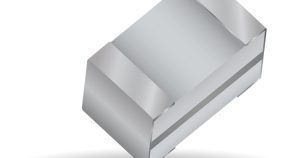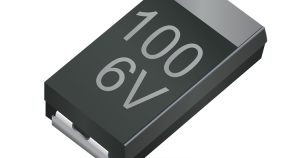Comparison of Multilayer Ceramic and Tantalum Capacitors Written By: Jeffrey Cain, Ph.D. Abstract: Engineers now have a choice between ceramic and tantalum when it comes to selecting capacitors with values between 0.1 – 22µF. As the ceramic material technology continues to advance, more and more capacitance is realized in the same case sizes compared to previous years. This paper will examine what devices are available and the trade off of using each of the technologies. The goal of this work is to help in selecting the proper device (tantalum versus ceramic) for a specific application.
Resources
Capacitor Array — An Integrated Passive Component Offering Benefits to the Automotive Sector Written By: Mark Stewart Abstract: By combining discrete capacitors into a multi-element package, AEC-Q qualified capacitor arrays offer automotive designers the opportunity to lower placement costs, increase assembly line output through lower component count per board and reduce real estate requirements.
The 3 Rs of IDCs: Reliability, Repeatability, Reparability Written By: Tom Anderson Abstract: Even after more than 50 years in the marketplace, insulation displacement connectors (IDCs) continue to prove themselves in new and demanding applications, such as automotive safety systems, solid-state lighting (SSL), and industrial sensors and controls. IDCs have provided a cost-effective and reliable alternative to crimp-to-wire and hard-soldering wires to a PCB.
Wireless Charging Written By: Ron Demcko Abstract: Yesterday’s dream of distributing power wirelessly is becoming a reality based upon exceptional efforts of industry regulatory agencies, component manufacturers, and design engineers with long-term vision. The use of wireless charging is expected to increase dramatically as consumers are freed from carrying bulky cables that have extra weight and the potential to wear out the mechanisms associated with them. Implementation of wireless charging schemes are easier than ever thanks to a wide availability of dedicated chip sets. Within the topic of wireless charging – there are several different power levels, architectures, and design approaches associated with wireless power transfer. This paper will serve as a starting point and describe the families of capacitors
Optimizing Antenna Performance Through the Use of High Q, Tight Tolerance Capacitors Written By: Ron Demcko Abstract: Antenna matching is an important aspect of any RF system. Thinking in traditional terms, a properly designed and matched antenna increases the operating distance of the wireless product. Well matched antennas can transmit more power from the radio – therefore transmit over longer distances. Likewise, a well matched antenna allows the maximum transfer of energy from the receiving antenna to the receiver front end. Thus, allowing better receive characteristics for the system. But the use of a capacitor can also have a big impact upon the physical size of an antenna. If the goal is a compact, integrated antenna, the use of a
Portable Electronics Require Smaller, More Modular SMT Battery Connectors Written By: Tom Anderson Abstract: Next-generation battery connectors face many new market demands, although the common ingredients remain the same: high life cycle, stability, simple design, and SMT compatibility.
Temperature Stability Assessment of GaN Power Amplifiers with Matching Tantalum Capacitors Written By: T.Zednicek | R.Demcko | M.Weaver | D.West | T. Blecha | F.Steiner | J.Svarny | R.Linhart Abstract: Wide band gap GaN and SiC devices are expected to experience high levels of growth in applications ranging from power conversion to RF transistors and MMICs. End users recognize the advantages of GaN technology as an ability to operate under higher currents and voltages. RF GaN market is expected to grow at 22.9 % CAGR over 2017-2023, boosted by implementation of 5G networks. [1] During the past years, the wide band semiconductors have reported achievement of >1000 V BDV that opens new challenges for high power industrial applications such as
Aluminum Electrolytic Capacitor Holder For Ruggedized Automotive Applications Written By: Tom Anderson Abstract: Harsh environments such as automotive and industrial applications can be very demanding on larger electronic components, which are exposed to severe shock and vibration requirements. In order to protect these components, extra attention and most often times cost needs to be devoted to the processing and mechanical attachment within the device to the Printed Circuit Board (PCB).
Solid Tantalum Capacitors: MnO2 vs. Polymer Cathodes for Optimal Performance in High-Reliability Military and Space Applications Written By: Ron Demcko Abstract: Solid tantalum capacitors have a long history of proven performance in high-reliability military and space applications. But not all capacitors are created equal — even within the same class. As is the case with virtually all component technologies, materials matter. This paper will discuss the differences in performance and reliability between solid tantalum capacitors with manganese dioxide (MnO2) cathodes and those with conductive polymer cathodes. Bell Laboratories introduced the first solid tantalum capacitors to market in the early 1950s. The first military specification for surface-mount tantalum capacitors (MIL-PRF-55365) was released in 1989 and introduced CWR09-style components. Since then, the
Reliability of SuperCapacitors: Long-Term Reliability Test Data (Part 2) Written By: Eric DeRose | Bob Knopsnyder | Bharat Rawal Abstract: Extensive testing of electronic components is required for an understanding of their device physics, their degradation behavior and their failure mechanisms for establishing their longterm reliability. Gaining a better understanding of part characteristics results in the utilization of the right part which can be recommended to customers depending on the application’s operating conditions such as voltage, temperature and relative humidity. Samples of all products produced are evaluated and tested for up to 4,000 hours to establish reliability test data. As we strive to be an industry leader in reliability of our supercapacitors or electric double-layer capacitors, we do our due
Reliability of SuperCapacitors: Unique Performance at 85°C & Self-Balancing (Part 1) Written By: Eric DeRose | Bob Knopsnyder | Bharat Rawal Abstract: Increasing use of supercapacitors on printed circuit boards (PCBs) is requiring a further understanding of the reliability of these components. As the use of these types of devices increases, the emphasis on reliability will become critical as sub-ppm failure rates are critical for minimizing and, in fact, eliminating rework of the PCBs in these applications. A broader understanding of the reliability of these devices will assist in reaching this goal. In this first of many publications, a study of our supercapacitor modules tested at 85°C at various applied voltages, at or below the rated voltage, will demonstrate the
RF Passive Components Made Using Multi-Layer Organic Technology Written By: Ron Demcko Abstract: RF circuitry might be based upon the use of discrete components, low temperature co-fired ceramics (LTCC), hybrid component technology, a combination of all these or more design methods/techniques – depending upon the frequency spectrum, circuit type and power of the circuit. A new family of RF components based upon laminating multiple layers of organic materials is emerging. These Multi-Layer Organic devices (MLO) offer significant electrical, physical and reliability advantages over traditional discrete RF or LTCC solutions. This paper outlines the basics of MLO devices. A discussion of the families of product offering and discusses performance advantages of MLO technology is provided.
High-Reliability Solid Tantalum Capacitors Written By: Bob Fairey Abstract: Solid tantalum capacitors are among the most popular types of small, surface-mount capacitors for electronic applications across the consumer, automotive, aerospace, and medical device markets. This paper will provide some context on the development of tantalum capacitor technology and address issues frequently faced by users, including the need for low equivalent series resistance (ESR) in filtering applications and the need for the highest possible reliability and long-lifetime performance in aerospace and medical applications.
The Frequency Response Effects of Internal Component Configuration on Multiple Ceramic Dielectric System Written By: S. Pala | R. Demcko | M. Berolini Abstract: The purpose of this paper is to discuss the frequency response effects of internal designs within ceramic systems. Those effects will be related to component performance parameters for devices used to suppress ESD and control EMI in high speed data lines, which are prone to be damaged by ESD. As communication speed increase, systems become more complicated and performance standards tighten, options to improve EMI/RFI performance becomes of great importance. Long term EMI performance and reliability are of particular importance in automotive, medical and aviation application sectors. A performance comparison will be made between single element
EMI Control Written By: Ron Demcko Abstract: EMI control is a key design goal in electronic systems. Three terminal FeedThru capacitor filters are one component option that can be used to simplify designs needing a broadband EMI filter response. The proper selection and use of SMT FeedThrus can lead to a variety of system improvements such as: reduced overall component count, less complex PCB layout, increasing manufacturability, improved reliability, and lower weight. It is because of these potential advantages that three terminal capacitors are now accepted in designs ranging from avionics to cell phones, automobiles to SMART grid controllers. This list of applications is growing as FeedThru capacitors evolve into smaller packages, obtain AEC Q200 qualification, and increase current ratings.
SMT Process Characteristics of AVX TransGuards Written By: Ron Demcko Abstract: TransGuards are uniquely suited for wide-scale usage in SMT applications. TransGuards exhibit many advantages when used in SMT assemblies. This paper is a general guideline aimed at familiarizing users with the characteristics of soldering multilayer SMT ZnO TransGuards.











